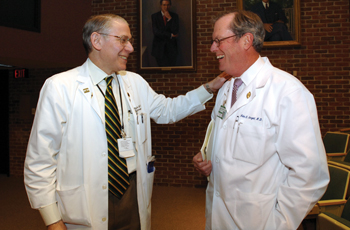
Dean Steven Gabbe, M.D., left, congratulates John Sergent, M.D., on receiving one of the Excellence in Teaching awards given at this week's Spring Faculty Meeting.
Photo by Dana Johnson
Faculty meeting outlines VUSM’s present, future
Vanderbilt University School of Medicine Dean Steven Gabbe, M.D., discussed growth, research, education, and planning issues before the presentation of this year's research and education faculty awards during Tuesday's Spring Faculty Meeting in Light Hall.
Gabbe's speech, “Five Year Review — Our Past, Present, and Future,” touched on various topics including leadership, an area where 12 new department chairs have been recruited over the past five years, and a series of interdisciplinary institutes created along with five interdisciplinary centers within the School of Medicine.
Full-time faculty has increased by 40 percent at VUMC — from 1,170 to 1,641 — since Gabbe succeeded John Chapman, M.D., as dean in March 2001.
VUSM now has one of the best faculty/student ratios in the country (ranked seventh in the nation), according to U.S. News & World Report's 2007 rankings released this week, with nearly four faculty members to every student (See related story page 2).
Gabbe praised VUSM's efforts in the area of faculty development, pointing to new initiatives including an extension of the tenure probationary period, recognition of team research, creation of a Faculty Advisory Council, a new parental leave policy, and the Master Clinical Teacher Program.
He commended Vice Chancellor for Health Affairs Harry Jacobson, M.D., and John Sergent, M.D., professor of Medicine and vice chair for Education, for their sponsorship of the Master Clinical Teacher Program, launched in 2002 to recognize increasing pressures on faculty to see more patients and do more research.
“We created this program to provide financial support for the very best teachers on our faculty so that they can work with our students at least one or two days a week,” Gabbe said. “This has enabled them to play an increasingly important role in our Clinical Transactions Project. It is the Master Clinical Teacher's responsibility to make sure that the students master competencies on their clinical rotations.”
From a medical student perspective, VUSM continues to attract outstanding students and those students are increasingly more satisfied with the quality of their education.
Student satisfaction has swelled by nearly 20 percent in two years, according to a 2005 AAMC Medical School Graduation questionnaire that shows over 80 percent of VUSM students now “strongly agree” that they are satisfied with the quality of their medical education, as compared to the national average of 39 percent.
The average MCAT score for attending students has been improving to one of the highest in the country (ranked 10th), overall GPA is 11th, and VUSM has the 12th most-competitive acceptance rate in the nation for medical schools.
Scholarships available for incoming students have more than doubled since 2002, from 17 to 37, with Dean's Scholarships increasing from 3 to 16 during this period.
The Emphasis program, a period of self-directed study during the first two years of medical school that matches a student's area of interest with a faculty mentor, is enabling students to choose from nine areas of interest for their study. On April 21 students in the program will present a paper or their research results.
In the area of diversity, VUSM is seeing an increase in its underrepresented in medicine (URM) student population, with 14 URM students in the class of 2008 and 13 in 2009. In comparison, there are seven in 2006 and eight in 2007.
Gabbe said U.S. News & World Report is placing too much emphasis on the new category of NIH funding per faculty member in its annual ranking of medical schools, noting that VUSM's drop from 18th to 24th in that category played a major role in its remaining in 17th place overall for the second consecutive year.
“We think this is a pretty poor indicator of the quality of a medical school,” Gabbe said of the new category.
While Gabbe disagreed with the U.S. News ranking, he noted a recent survey by The Scientist magazine that placed VUSM in the Top 15 of 114 North American institutions in its “Best Places to Work for Postdocs” survey.
Looking forward, Gabbe speculated that overall reductions in both NIH and TennCare support create challenges ahead but expressed optimism about continued excellence for the School's efforts in research, education and patient care.
Last Thursday, Gabbe delivered his State of the Medical School address to medical students, graduate students and postdoctoral fellows, noting that VUSM is the first school to apply the five elevate pillars – people, service, quality, growth and financial performance – to education and research.
“No one has done this before,” he said. “It has always been applied to the quality of patient care and staff and physician satisfaction.”













